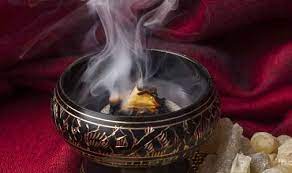
Role of Dhoopan in Slowing Down COVID Spread
- 19 Nov, 2021
- Posted by admin
- 0 Comment(s)
- Dhoopan is an Ayurvedic procedure in which fumes or smoke produced from defined Ayurvedic drug formulations are inhaled/exposed by patients for medicinal/therapeutic relief or externally as a cleanser to the environment.
- There is a major risk of spread of airborne infections with hospital-acquired infections and to mitigate Dhoopan is a safe practice and very effective to control such infections.
- Dhoopan is a classical ayurvedic method of sterilization for Vranitagar (wound healing), Sutikagar, Kumaragar, etc. with preventive as well as curative/restorative efficacy. Fumes can be facilitated to expose or inhale in various diseases such as cough, fever, coryza, piles, epilepsy, insanity, Asthma, bronchitis, and wounds.
- The constituents of Dhoopare Ayurvedic herbs, animal products (like skin, hair, bones, horn, etc.), and various minerals, described in Ayurveda are efficient anti-microbial, anti-fungal, and antiviral action by nature.
- Since ancient times, sages used to clean the environment by havanaadi (home)rituals. However, because of the lacking scientific validation, these Dhoopan practices are not famous, which bring attention to research opportunities and understand its safety, potency, and efficacy to control airborne infections.
- Dhoop kalpas have advantages in dealing with airborne infection because of antioxidant and anti-microbial properties with safe, economical, and eco-friendly potential. Thus, it can be publicized in the prevention and control of COVID 19 like a pandemic situation as a supplementary method.
- Airborne infections are the commonest ones, develop respiratory disorders. COVID 19 is one of the viral respiratory problems, created pandemic with a high death rate. Covid spreads from droplets, aerosol, and fomite by the affected patient’s cough, nasal secretions, sneeze, sputum, or nasal discharge, and the environment gets easily contaminated.
- Airborne infections can rapidly spread in masses through breathing and inhalation of microbes in an infectious environment. Therefore, this is required to sterile the area by disinfectant herbs or fumigation.
- There are many types of microbes present everywhere in the environment. Hence, it is a protocol to fumigate operation theatre before surgery to prevent hospital-acquired infections.
- Recently, Dhoopan is rarely used as a fumigation method. Therefore, re-publicize the advantages of Dhoopan karma and evaluate the efficacy of different Dhoop kalpas for fumigation purposes Rakshoghna (anti-microbial) with safe and quick action to prevent airborne infections.
Action
There are many common drugs such as Guggulu, Sarja, Arishtak/Neem, Rason , Haridra, Sarshapa , cow dung cakes , Ghrit , Hing , Vidanga , Yava ,Aparajita , Vacha , Devdaru , Daruharidra, Bilva , Lakh, Atasi, Bramhi, Jatamansi, Sarpanirmok/skin of snake etc. Almost all the Dhoopan dravya have an action of deodorant, antiseptic, analgesic, antipyretic, vishhar, anti-inflammatory, Rakshoghna (anti-microbial), etc. by spreading pleasant aroma to fill in the air. The action of these drugs has been proven to the efficacy for improving health as well as prevention and control of diseases as they are anti-microbial by nature. Their classification has been done as per Samhita (Charak, Ashtang Hridaya, Sushrut, and Ashtang Sangraha), diseases, indications, and confirmed action with references.
Preparation of ‘DHUP’
The drugs which are recommended for Dhupana are selected classically and to be taken in mentioned (in detail) proportion. The ingredients are coarsely powdered separately and a homogenous mixture of herbs is prepared by mixing all the ingredients.
Composition
| Sr. No. | Dravy | Latin Name | Family | Official Part | Proportion |
| 1. | Guggulu | Commifera mukul | Burseraceae | Niryasa | 1.5 parts |
| 2. | Ushira | Vetiveria zizanoidsLinn. | Graminae | Root | 1.5 parts |
| 3. | Vacha | Acorus calamusLinn. | Araceae | Rhizome | 1 parts |
| 4. | Rala | Shorea robustaGaertn. | Dipterocarpaceae | Niryasa | 1.5 parts |
| 5. | Nimba | Shorea robustaGaertn. | Dipterocarpaceae | Niryasa | 1.5 parts |
| 6. | Arka | Calotropis proceraLinn. | Asclepiadaceae | Moola | 1.5 parts |
| 7. | Devadaru | Cedrus deodaraLoud. | Pinaceae | Bark | 1.5 parts |
| 8. | Loban | Boswellia carteriiRoxb. | Bursuraceae | Niryasa | 3 parts |
Dhoopana Procedure
200 grams of dry cow dung cakes are to be burned with the help of mentholated spirit in a sharava. The sharava is kept in the center room and smoke is generated by subjecting dhoopan dravya to fire. 25 grams of Dhoopan dravya to be burned little by little for about ten minutes. Then the room should be closed for an hour. The procedure can be done during day time.
Reference
- In Bhaishjya Ratnavali text Out of a total of 14 Dhoomkalpas, three indicated fever, three for Kasaand remaining for Graha, pilla, shool, Arsharoga, Vranaropan.
- In Ras RatnaSammuchhaya, a total number of eight kalpas are mentioned for Kasa, Shwas, and Graha.
- In BharatBhaishajya Ratnaka classical text, many Dhoopkalpas are mentioned in detail for Hikka roga, Kandu, Krimi, Shoola, Netravikar, and Jwar disorders taken from these texts Gadnigraha, Yogratnakar, VangSen, Bhavprakash nighantu, and Brihat Nighantu Ratnakar.
- In Sharangdhar Samhitaalso Dhoopan karma or fumigation is indicated in ulcer and respiratory ailments in a different chapter named Dhumrapan vidhi.
